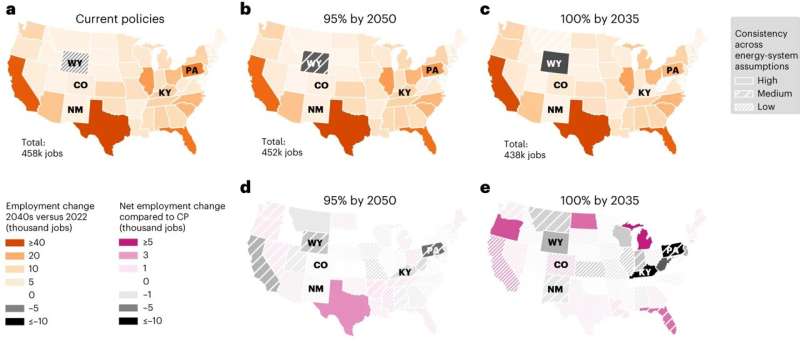This article has been reviewed according to Science X's editorial process and policies. Editors have highlighted the following attributes while ensuring the content's credibility:
fact-checked
peer-reviewed publication
trusted source
proofread
America's low-carbon transition could improve employment opportunities for all

The U.S. is likely to see consistent job growth from the transition to net zero, but the gains will be unevenly distributed, shows a new analysis. The analysis, conducted by Imperial College London researchers and published today in Nature Climate Change, shows that some states will need new policies to ensure a 'just' transition.
The U.S., alongside many countries, is planning for a low-carbon future, where energy production releases little to no carbon dioxide and what is released is removed from the atmosphere, creating net-zero carbon emissions. This has been backed by new policies, including the 2022 Inflation Reduction Act, which includes large investment into domestic clean energy production.
This move to renewable energy sources is essential to curb global heating, but its impact on employment is uncertain. Now, researchers from Imperial College London have carried out an analysis to understand what kinds of jobs are likely to be created at a state level, and the societal implications of different scenarios for low carbon transitions in the US electricity system.
They found that decarbonization brings consistent job growth. However, major fossil fuel-producing states need to prepare for fewer mining jobs by looking to create other opportunities.
Ensuring a just transition
The analysis shows lowest-skilled workers will experience more uncertain employment outcomes, so states need to plan carefully to make sure the energy transition is 'just'—fair to all. Sizable new opportunities will be available to workers with some training though, in the utilities and construction sectors.
The team also found that the renewable energy sector generally employs more women, which could boost gender equality in fossil fuel-dependent states, but not enough to disrupt the national gender status quo.
First author Judy Jingwei Xie, from the Centre for Environmental Policy and the Grantham Institute at Imperial, said, "Overall, our analysis is good news: recent policies such as the Inflation Reduction Act will lead to consistent job growth. There are some states currently very reliant on fossil fuel production that could lose out, but there are tools available for them to get ahead of the problem and take advantage of the situation to turn themselves into leaders of the clean energy revolution."
"By boosting retraining opportunities for the existing workforce and training young people in low-carbon technologies, traditional coal-producing states like Wyoming could put themselves at the forefront. The new American Climate Corps can provide these opportunities if it manages to deliver the targeted compensatory support to communities in need."
Global goals
To conduct the analysis, the team used the Regional Energy Development System (ReEDS) energy system model developed and maintained by the US National Renewable Energy Laboratory. This includes 70 detailed future energy system scenarios, which they fed into a model of how these would impact employment across states based on their energy profile and demographics.
The wide range of scenarios included the US Long-Term Strategy, which aims for 100% reduction of electricity system carbon emissions by 2035 and showed consistently positive job growth. The team have made their code openly available, allowing integration of new policies, and the ability for models to be created for other countries and regions, as long as the right input data is available.
Co-author Dr. Iain Staffell, from the Centre for Environmental Policy at Imperial, said, "A lot of new stuff needs to be built to transform the energy system globally, and the Inflation Reduction Act in the US has created some key conditions for big companies to make this shift.
"The U.S. and China are ahead in this regard, and if we in the UK want a part of this boon, we need similar policies to incentivize the rapid shift to clean energy, which would boost employment and progress towards global goals of reducing carbon emissions."
More information: Judy Xie, Distributional labour challenges and opportunities for decarbonizing the US power system, Nature Climate Change (2023). DOI: 10.1038/s41558-023-01802-5. www.nature.com/articles/s41558-023-01802-5



















